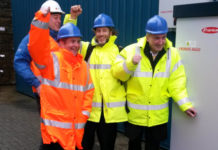Data underpins every aspect of modern life, with more information generated now than ever before. Keeping data centres cool is crucial for their safe and effective function, but due to the amount of waste heat they generate, it requires significant power consumption. Glasgow-based Katrick Technologies has developed and patented a passive cooling system that removes waste heat without external power required. Katrick Co-CEO Vijay Madlani examines the costs of data centre cooling and how new systems can improve efficiency.
We generate more data than ever before, with 44 zettabytes of data in storage as of 2020 and this expected to increase to over 200 zettabytes by 2025. To put this into perspective, a single zettabyte is equivalent to one trillion gigabytes. Much of this data is stored in data centres; dedicated facilities containing servers to store large amounts of data. Data centres are an integral part of the global economy, storing everything from our personal information to business and infrastructure data.
With the nature of data stored in these centres, and the extreme sensitivity of some content, they require their own infrastructure, security, networks, and backup power supplies to limit the damage of potential problems. Environmental conditions are also highly important to ensure function and keeping data centres at an appropriate temperature round the clock can prevent overheating and failure of critical equipment, especially as they produce large amounts of heat as a by-product.
In the UK there are approximately 400-450 data centre facilities, and TechUK estimates they consume 6TWh annually to run, not including the 3-4TWh required for server rooms. This figure is set to rise exponentially as the number of data centres increases, with a 2018 Nature study estimating that they will be responsible for 8,000 TWh of consumption by 2030.
Keeping data centres cool uses a significant amount of this energy, with air conditioning and handler units used by 90% of the UK data centre market estimated to use 26 to 41% of the total energy consumed.
These figures highlight why it is so crucial to find more efficient solutions for data centres — as the need for these facilities increases, the amount of power required to run them while minimising the risk of failures will also rise. This is the motivation behind the Katrick Technologies passive cooling system.
Solutions in technology
Katrick’s solution removes excess heat without the need for any external power, keeping centres at a constant ideal temperature and reducing energy consumption. The patented technology offers a zero-carbon alternative to traditional cooling units, while being cost effective and kinder to the environment.
The passive cooling system uses a Thermal Vibration Bell (TVB) heat engine to maintain consistent cool temperatures in a data centre environment. The TVB has a chamber containing bi-fluids of different densities and expansion rates. The base fluid is high-density with a lower boiling point, and the fluid above is lower-density but with a higher boiling point. When these fluids are exposed to a heat source, a dynamic movement is created as the lower fluid boils more rapidly, creating bubbles which move through the fluid above. This converts heat energy into fluid vibrations.
These vibrations are then captured by an array of fins in the TVB, which protrude both internally and externally. This occurs through a range of different effects, including density change, bubble velocity, and the generation of convection currents within the fluids as they interact with variable temperature levels.
The energy from the fluid vibrations is captured by the fins and transferred to mechanical vibrations, causing the fins to oscillate. This movement dissipates the unwanted heat in the environment, providing cool temperatures to allow the servers to work and avoiding overheating.
The technology has been trialled at iomart’s data centre in Glasgow as of October 2021, where a 120kW capacity TVB system was installed. Initial results from this trial indicate that implementing Katrick’s TVB engine can reduce power consumption by the site’s cooling system by up to 50% and may even reduce a data centre’s total energy consumption by 25% overall.
Alongside the benefits of energy efficiency and sustainability, the bi-fluids used within the passive cooling system have been certified 100% environmentally safe, with next to zero global warming potential and zero ozone depleting potential. They also pose no fire risks or health hazards, allowing employees to safely work with the system.
Katrick’s system is designed to be modular and scalable, tailored to the end-user based on their specific requirements and the size of their facility. The reduced requirements for chillers will also lead to reduced maintenance, prolonging the overall life of the site. The energy produced by the system can even be re-routed to additional server capacity with limited supply, making it a profitable option to increase revenue and margin overall.



